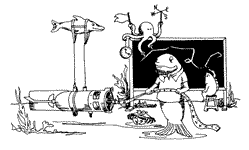
|
The IEEE Seventh Working Conference on Current Measurement TechnologyCurrent and Wave Monitoring and Emerging TechnologiesMarch 13-15 | Bahia Hotel | San Diego, CA, USA |
||
|
Technical Program Accomodations Order the Proceedings Committee and Contact Info |
||
Compliant Mooring Technology to Separate Buoy Motion from In-line Current ObservationsJames D. IrishWoods Hole Oceanographic Institution Phone: 508-289-2732
David W. Fredriksson A problem with many older momentum transfer current meters was their non-linearity to sinusoidal mooring motion that induced errors in current measurements. More modern acoustic travel time and Doppler current meters do not have this same problem, but still may be plagued by mooring motion effects that result from aliasing due to the surface wave field. Therefore, to separate buoy motion from current meter and other sensors on the mooring line to minimize the wave effects, compliant elastic elements have been used in the mooring directly under the buoy. Our first use of this approach was in the Massachusetts Bays Program where VMCM current meters were used in the surface waters just under the buoy, and VACM current meters were used below the elastic element for deeper current measurements. The most recent application is in a mooring designed to measure waves with accelerometers in a surface following buoy yet with minimum effect on the instrumentation below the buoy on the mooring. Compliant elastic elements at the top of the mooring allow the buoy to move freely with the waves without it having to accelerate the mooring with instrumentation (an ADCP and SeaCats) to follow the water surface. The ADCP was mounted near the bottom in an upward looking configuration and additional flotation at the bottom of the elastic elements kept the lower part of the mooring taut to minimize the vertical and horizontal motions. The elastic elements pretensioned the mooring to about 200-300 lbs, and depending on the horizontal current and the wave activity the tension may rise to about 400 lbs. WHOI Cable modeling of the mooring showed no vertical motion in the lower part of the mooring and reasonable tensions that would allow the buoy to follow the waves. Data from the accelerometer in the buoy, the SeaCats in-line and the ADCP was of high quality. The mooring was recovered by releasing a float from mid-depth that brought a line to the surface from below the elastic elements to allow the mooring and anchor to be retrieved. In future deployments, coil-cord conductors around the elastic will provide power and telemetry of currents and deeper water properties to the buoy for relay to shore by spread spectrum radio. Submitted on October 25, 2002
|
|
Sponsored by the Current Measurement Technology Committee (CMTC) of the IEEE Oceanic Engineering Society. All content reserved. Contact jrizoli@whoi.edu for more information. |
||